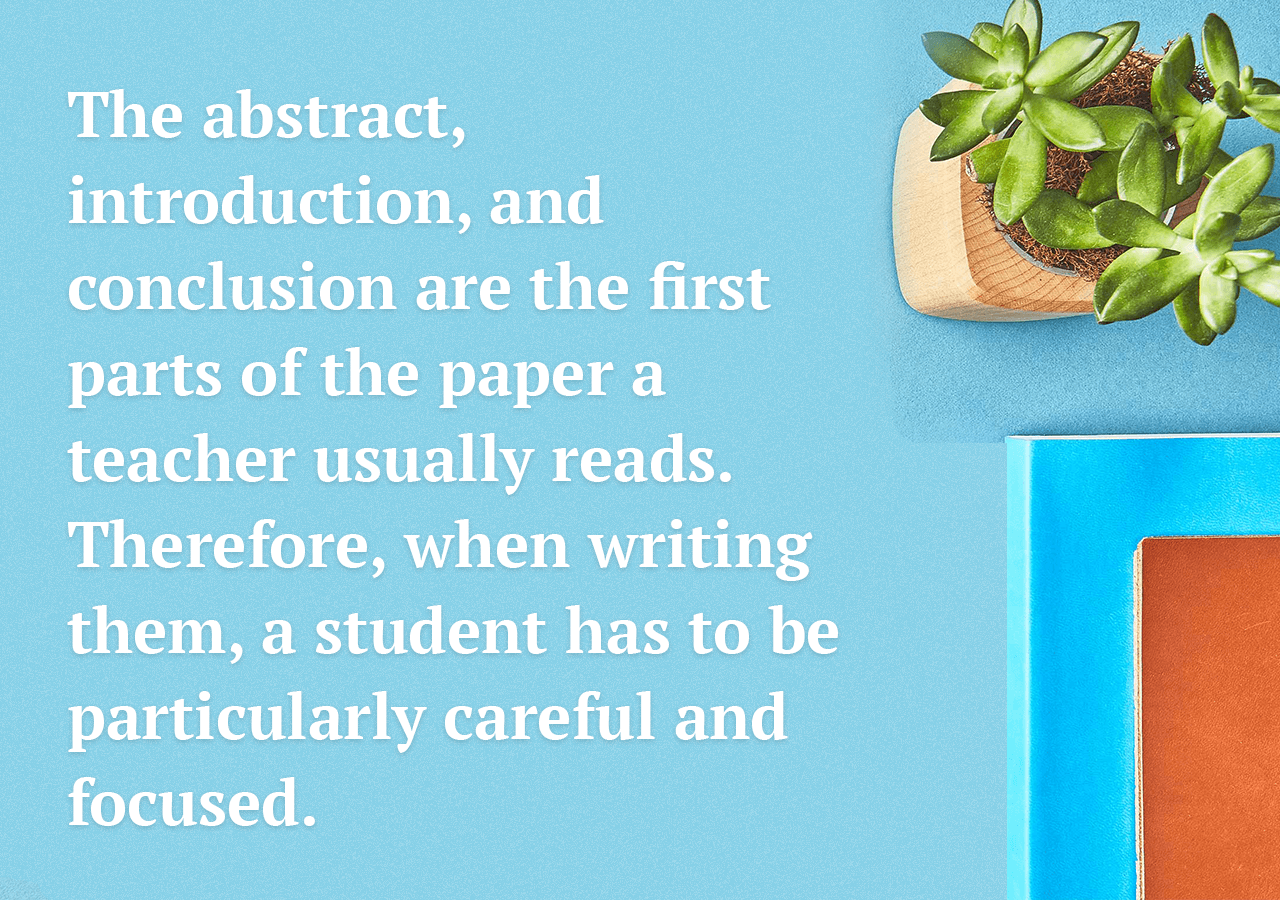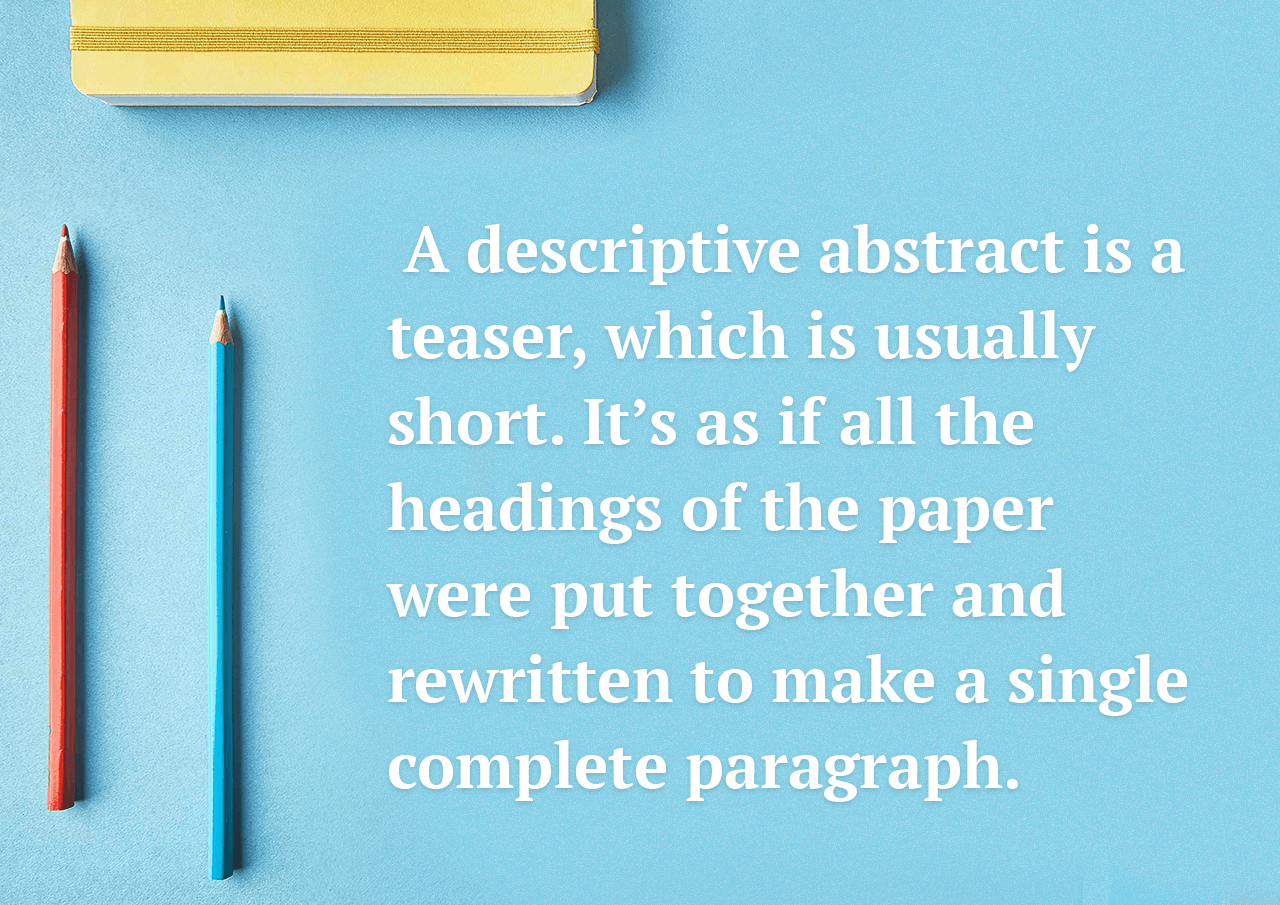How to Write an Abstract
How to Write an Abstract—Complete Guide (With Examples)

Even if it seems minor compared to an essay, research paper, or case study, you shouldn’t underestimate the importance of an abstract. In fact, it’s a vital part of all the written works that we’ve just mentioned.
But what does abstract mean anyway?We will write a custom essay specifically for you
for only $16.05 $11/pageLearn more
An abstract is a short summary of a thesis, article, review, analysis, or any other in-depth academic work or writing. Its main purpose is to help readers understand what a particular paper is about and what its purpose is.
An abstract usually goes at the very beginning, before the actual work it describes. It serves as a sort of introduction to the paper.
What is an abstract good for?
Apart from what we’ve mentioned in the definition, an abstract can act as an independent piece of work instead of a complete paper. It’s especially helpful in situations where a certain type of research paper or other writing needs to be selected, but there’s no time to look through the whole thing.
There are even whole databases that index abstracts only. Because most of the time, scientific works fall under a certain copyright. And having abstracts really helps students and researchers find them without violating any laws or rights.

Source: https://thesistips.wordpress.com/2012/03/25/how-to-write-your-introduction-abstract-and-summary/
And you know what?
Today you’re going to learn how to write an abstract.
Here at writers-corp.net we thought that it would be a great idea to provide our readers with a complete guide on abstracts. A guide that will tell all about how to prepare for writing an abstract—including its types, components, and structure—and that will lead you step-by-step through the writing process itself. You’ll know how to write any type of abstract, whether it’s an abstract for project, research paper, case study, or any other written work.
But that’s not all.
You’ll also find a bunch of abstract examples in this guide. How cool is that?
So, if you’re ready, let’s jump in and learn about writing an abstract.
How to Write an Abstract: Getting Started
There are a couple of things to consider before you start to write an abstract.
- First things first, you obviously need to have your paper ready. This one should be a no-brainer, but it’s still worth mentioning. If you try to write your abstract before the work itself, chances are you’ll have to edit it a lot afterwards.
- Make sure you’re aware of all the requirements: writing style, length, and the whole purpose of an abstract. All of these factors will influence the contents of your abstract. Again, it’s better to do everything right from the beginning than to have to edit your work later.
- Think of the audience. Remember the definition of an abstract? It helps readers understand what your work is about. You need to be aware of who’s going to read it. Are they going to be scientists who’ll use your abstract to decide whether your work is relevant? Or do you need to make your abstract easy to understand for regular readers, or those out of your field? Answering these kinds of questions will help you determine how your abstract will look.
- Decide on the type of abstract. This is one of the most important aspects. Therefore, we’ll talk about it in the next part of our guide.
Helpful tips for writing an abstract
How to write an abstract
Types of Abstracts
When it comes to naming the types of abstracts, there’s really only two: informative abstracts and descriptive abstracts. However, there’s a third category that isn’t as common but is still worth mentioning.
We’ll talk about that one after describing the first two, so stay with us.
Informative abstract
This type of abstract writing is also known as a complete abstract.
And it’s pretty self-explanatory.
An informative abstract acts as a summary of a paper, describing its purpose, methodology, background, results, and conclusion. It also includes information about the structure of the paper, its key thoughts, and the major topics discussed.
How long should an abstract be?

Source: https://www.tu-chemnitz.de/phil/english/sections/linguist/independent/kursmaterialien/TechComm/acchtml/abstrax.html
An informative abstract usually sticks to around 250+ words. The completeness of the information provided in it makes it possible to use the informative abstract as an independent document. In fact, a format similar to informative abstracts is used to write short scientific reports.
Descriptive Abstract
This type of abstract is also called an indicative abstract, or a limited abstract.
Again, the name says it all.
This type of abstract paints a general description of what the paper is about, without going into very in-depth details.
In the case of an informative abstract, you can clearly come up with an opinion about the paper based on the abstract alone. With a descriptive abstract, though, you’ll still have to read the main work, because the abstract will only provide a general idea, without all the vital pieces of content.

Source: https://www.prismnet.com/~hcexres/textbook/abstrax.html
It’s more like a table of contents, but written in the form of paragraph. And it’s usually about 100-200 words long.
Speaking of that third type of abstract…
Scientific works published by Elsevier include graphical abstracts together with the text versions. These abstracts act as a visual summary of the main points or thoughts provided in the main work.
There have been debates over whether it’s suitable to replace regular abstracts with graphical ones in some type of publications. Graphical abstracts have gained quite a decent following, as well as a fair share of criticism. Which have made them less popular overall.
- Types of abstracts
- How to write informative abstracts
- Writing informative abstracts
- Descriptive abstracts
Abstract Contents and Structure
Despite the fact that abstracts are usually short, there are several components you can and should fit into one.
But how?
It’s actually pretty simple. All of the abstract parts that we’re going to mention below usually take one or two sentences each (sometimes a bit more). As a result, you end up with a work that’s just 100-250 words long.
And, as with any other written work, proper abstract format matters just as much as the format of the main paper.
So, what are the components of an effective abstract?
1. Motivation
This part explains why the topic you chose was interesting to work with. Which also tells the readers why it should be interesting to them.
You don’t necessarily have to describe the motivation at the very beginning of your abstract.
Here’s the thing.
If the work itself contains some unique findings and discoveries, it might be better to state the problem first. The findings will speak for themselves, so you won’t have to try and find ways to attract your readers even more.
But if you consider your work to be pretty ordinary, then it’s probably worth starting your abstract with a “hook.”
2. Statement of the problem
This is the part where you tell what exactly your work was and what problem you were trying to solve.
Be careful, though.
Along with keeping this part informative, it’s important to try not to use too much specialized terminology or jargon. Especially if you’re starting your abstract with a problem statement.
3. Approach

Here, you’ll describe what you did to solve the problem or make progress on it.
Tell all about the methodology you used, the strategies you followed, and the kind of data you worked with. Also, you can mention how big the scope of your work was.
4. Result
This one is important.
Not to say that the other parts are less valuable, but finding answers or solutions was the very reason you started your work in the first place. So, everyone will want to know what you came up with.
You have to state the results as clearly as possible. Otherwise, your readers will question the relevance of your whole work.
5. Conclusion
It might seem that you could end it all there with the results section.
But that’s not all.
You also should explain what your findings are good for. People should know whether there’s going to be some practical use for your work or whether it just provides some important information.
In the conclusion, you can also mention the possibilities for further research in your field.
All the components we’ve mentioned above make the perfect structure for most abstracts. An abstract usually reflects the logical structure of the work it describes.

Source: https://www.academic-conferences.org/policies/abstract-guidelines-for-papers/
Some abstracts may also include references, although it’s not that common. Usually, references are included only within the paper itself.
We’ve already talked about how the length of an abstract depends on its type. Another aspect that can influence the length is the field in which you’re writing your work, as well as any other additional requirements. Knowing that, an abstract’s length can sometimes reach up to 500 words. But it usually won’t take up more than a single page.
Want to know more about the parts and structure of an abstract? Check out these links.
- Checklist: parts of an abstract
- The components of abstracts
- Elements of a successful abstract
- Structured abstracts
- How to write an abstract for your thesis or dissertation
- How to structure your dissertation abstract
Writing an Abstract: Step-by-Step
The same set of components can also be used as a checklist for writing your abstract.
Let’s do a quick recap and go step-by-step through the whole process.
1. Identify the purpose
Tell your readers why your work matters and why it is important.
Answering the following questions will help you with identifying the purpose of your work:
- Why did I decide to study this particular topic?
- How did I do my research?
- What were my results and findings?
- What is the greatest importance of my findings and research?
- Why would anyone read my paper in its entirety?
2. Explain the core problem
You have to talk about the problem clearly so that your readers will have no extra questions after reading the abstract.
Keep this topic separated from the first one (identifying the purpose of your work) for the sake of being able to name the exact issues that you wanted to tackle in your work.
Here are some questions to answer. They will make it easier for you to think this part through:
- What is the problem that you’re trying to solve or understand better through your research?
- Is this a general issue or something specific?
- What are the main arguments and claims that you’ve made throughout your work?
3. Talk about the methods

Now it’s time to take care of telling how exactly you reached your goal.
- Describe your research process. Mention the approach you decided to go with and all the data that was at your disposal.
- It’s worth giving a short overview of the most important sources that you used for your paper.
- Mention the evidence that supports your claims, so the readers know there’s a foundation to what you’re saying.
4. Share the results
This is where the main difference between the two types of abstracts comes into play.
You see, it’s only informative abstracts that contain this information. So, if you’ve decided to go with the descriptive type, you may skip this step.
If stating the problem can be considered a question, then this part is the answer to that question. Describe all your general findings as well as the goal that you reached through your research. Support your words with arguments and hypotheses.
5. Write a conclusion
Not only will this part be a logical finish to your abstract, but it will also make a smooth transition to its closure.
Explain what your findings mean and why they make your paper important.
While this part is necessary both for informative and descriptive abstracts, it’s only the former that needs to answer the following questions:
- What implications does your work have?
- Were your findings specific or general?

Source: https://writing.wisc.edu/handbook/assignments/planresearchpaper/
Giving the answers to these questions will bring your readers a better understanding of what you’ve achieved with your work. And what the possible ways of continuing your research are (if necessary at all).
Follow the links below to get extra information on writing an abstract.
- A 10-step guide to make your research paper abstract more effective
- How to write an abstract
- Ten steps to writing an effective abstract
- Steps to writing research paper abstracts
- How to write a scientific abstract in 7 steps
- Writing an abstract
- How to write a scientific abstract in six easy steps
Abstract Examples
This guide wouldn’t be complete if we left you without an example of an abstract, would it?
Let’s be honest: would anyone learn how to write an abstract without a single example?
We don’t think so.
That’s why we’ve gathered all these links, each containing samples of abstracts. With these examples, you won’t need to search for an abstract template, because you’ll see how easy it is to write one yourself.
We hope that you’ve found this guide helpful and that writing an abstract won’t be any trouble for you.
And now, the links
Our Advantages
Quality Work
Unlimited Revisions
Affordable Pricing
24/7 Support
Fast Delivery